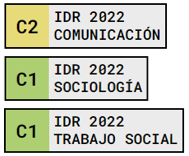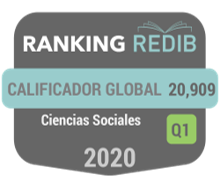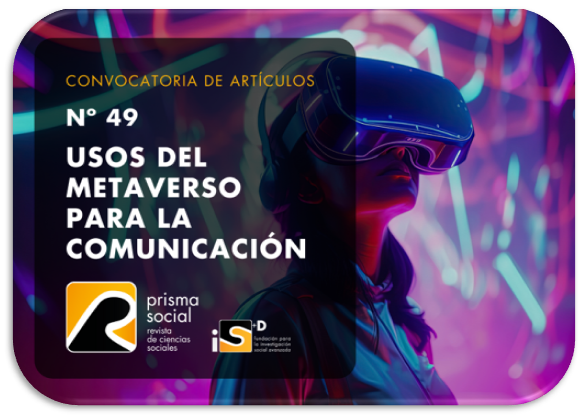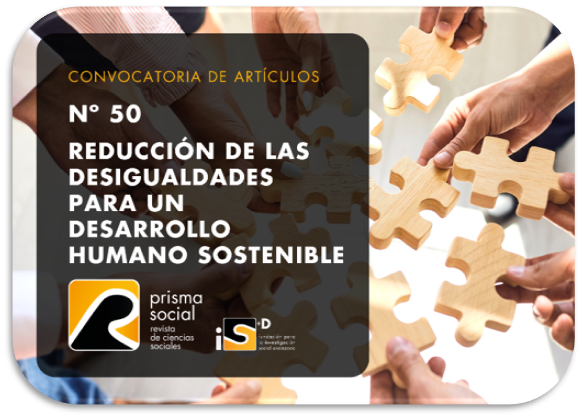Public-private controversies in social networks and adolescence.
Survey study
Keywords:
teenagers, social networks, public-private, privacyAbstract
Public exposure in digital environments is a common social practice among contemporary teenagers that forges new geographies for traditionally private realities. This study analyzes the perception of the teenagers of Compulsory Secondary Education of Galicia (Spain) about what they consider public or private in social networks, the implications of their participation and the regulations of the platforms. The public-private is visualized as the axis of the controversies that feed the new subjectivities. The exhibition imperative generates capital and social recognition that results in margins of satisfaction strained by modesty or possible digital risks. Through a descriptive-comparative methodology based on an ad hoc questionnaire applied online, the results warn that teenagers with a profile on social networks publish content due to a need for exposure. The composition of the audience and the idealization of the reality to be shown are factors that affect the publication of content. Significant differences in public-private treatment are identified according to the type of participation in these environments. The conclusions highlight the need for a critical training connected with the adolescent reality.
Downloads
References
Adjei, J.K., Adams, S., Mensah, I.K., Tobbin, P.E. y Odei-Appiah, S. (2020). Digital Identity Management on Social Media: Exploring the Factors That Influence Personal Information Disclosure on Social Media. Sustanbility, 12(23), 9994. https://doi.org/10.3390/su12239994
Alemany, J., del Val, E. y Garcia-Fornes, A. (2020). Assessing the Effectiveness of a Gamified Social Network for Applying Privacy Concepts: An Empirical Study with Teens. IEEE Transactions on Learning Technologies, 13(4), 777 - 789. 10.1109/tlt.2020.3026584
Arendt, H. (1993). The Human Condition. The University of Chicago Press.
Arfuch, L. (2006). Las subjetividades en la era de la imagen: de la responsabilidad de la mirada. En I. Dussel y D. Gutiérrez (Coords.), Educar la mirada: políticas y pedagogías de la imagen (pp. 75-84). Manantial.
Balleys, C., Millerand, F., Thoër, C. y Duque, N. (2020). Searching for oneself on YouTube: Teenage peer socialization and social recognition processes. Social Media+ Society, 6(2), 1-11. https://doi.org/10.1177/2056305120909474
Barrenengoa, P. D. (2020). Conjeturas sobre la subjetivación digital. Revista de Psicología-Tercera época, 19(1), 120-137. 10.24215/2422572Xe052
Bauman, Z. y Lyon, D. (2013). Vigilancia líquida. Paidós.
Bobbio, N. (2004). La gran dicotomía: público/privado. Por una teoría general de la política. Fondo de Cultura Económica.
Bourdieu, P. (1986). The forms of capital. En J.G. Richardson (Ed.), Handbook of Theory and Research in Sociology Education (pp.241-258). Greenwood.
boyd, D. M. y Ellison, N. B. (2007). Social network sites: Definition, history, and scholarship. Journal of computer-mediated Communication, 13(1), 210-230. https://doi.org/10.1111/j.1083-6101.2007.00393.x
Buckingham, D. (2015). Defining digital literacy-What do young people need to know about digital media? Nordic journal of digital literacy, 10(4), 21-35. 10.18261 / ISSN1891-943X-2006-04-03.
Claresta, H. y Tamburian, D. (2021, August). Self-Disclosure of Adolescent Girls on TikTok Social Media. In International Conference on Economics, Business, Social, and Humanities (ICEBSH 2021) (pp. 800-806). Atlantis Press.https://doi.org/10.2991/assehr.k.210805.126
Cohen, J. (1988). Statistical power analysis for the behavioral sciences. Lawrence Erlbaum Associates.
Coleman, J. (1988). Social Capital in the Creation of Human Capital. American Journal of Sociology.
Corral, Y. (2009). Validez y confiabilidad de los instrumentos de investigación para la recolección de datos. Revista de Ciencias de la Educación, 19(33), 228-247. http://servicio.bc.uc.edu.ve/educacion/revista/n33/art12.pdf
De la Peña, G. (2001). Público-privado, espacio-territorio: ¿de la dicotomía a la convergencia? Revista de Humanidades: Tecnológico de Monterrey, 10, 95-108. https://www.redalyc.org/pdf/384/38401004.pdf
Deleuze, G. (2006). Post-scriptum sobre las sociedades de control. Polis. Revista Latinoamericana, (13). https://journals.openedition.org/polis/5509
Deleuze, G. y Guattari, F. (2004). Mil mesetas: Capitalismo y esquizofrenia. Pretextos.
De Piero, J. L. (2019). ¿Es posible hablar de subjetividades digitales? Revista Electrónica de Psicología Politica, (42), 30-40. https://www.aacademica.org/jose.luis.de.piero/18.pdf?view
Del Prete, A. y Redon, S. (2020). Virtual social networks: Spaces of socialization and definition of identity. Psicoperspectivas, 19(1), 1-11. http://dx.doi.org/10.5027/psicoperspectivas-vol19-issue1-fulltext1834
Dennen, V. y Rutledge, S. (2018). The embedded lesson approach to social media research: Researching online phenomena in an authentic offline setting. TechTrends, 62(5), 483-491. 10.1007/s11528-018-0315-4
Duffy, B. y Chan, N. (2019). “You never really know who´s looking”: Imagined surveillance across social media platforms”. New Media and Socety, 1(21), 119-138. https://doi.org/10.1177/1461444818791
Dumont, L. (1987). Ensayos sobre el individualismo: una perspectiva antropológica sobre la ideología moderna. Alianza.
Escobar-Pérez, J. y Cuervo-Martínez. (2008). Validez de contenido y juicio de expertos: una aproximación a su utilización. Avances en Medición, 6, 27-36. http://www.humanas.unal.edu.co/psicometria/files/7113/8574/5708/Articulo3_Juicio_de_expertos_27-36.pdf
Foucault, M. (1982). The subject and power. Critical Inquiry, 8, 777–795. http://www.jstor.org/stable/1343197
Foucault, M. (1990). Tecnologías del yo y otros textos afines. Paidos Iberica Ediciones SA.
Foucault, M. (2002). Vigilar y castigar: Nacimiento de la prisión. Siglo Veintiuno.
Fr??il?, C. O. (2021). Motivation of TikTok users. International Journal of Current Science Research and Review, 4(12), 1640-1644. 10.47191/ijcsrr/V4-i12-04
Goffman, E. (1971). La presentación de la persona en la vida cotidiana. Amorroutu.
Gray, L. (2018). Exploring how and why young people use social networking sites. Educational Psychology in Practice, 34(2), 175-194. https://doi.org/10.1080/02667363.2018.1425829
Habermas, J. (1962). The Structural Transformation of the Public Sphere. MIT Press.
Hernández-Serrano, M. J., Jones, B., Renés-Arellano, P. y Ortuño, R. A. C. (2022). Analysis of Digital Self-Presentation Practices and Profiles of Spanish Adolescents on Instagram and TikTok. Journal of New Approaches in Educational Research, 11(1), 49-63. https://doi.org/10.7821/naer.2022.1.797
Hernández-Serrano, M. J., Renés-Arellano, P., Ortuño, R. A. C. y González-Larrea, B. (2021). Privacy in social networks: analysis of the Spanish teenagers' digital selfrepresentation risks. Revista Latina de Comunicación Social, (79), 133-154. 10.4185/RLCS-2021-1528
Hwang, L. A., Ng, J. W. J. y Vaithilingam, S. (2019). Social capital and subjective well-being: The mediating role of social networking sites. First Monday, 24(10). 10.5210/fm.v24i10.10130
Koskela, H. (2018). Exhibitionism as the New Normal: From Presenting to Performing. En B. Doringer y B. Felderer (Eds.), Faceless (pp.249-266). Edition Angewandte. https://doi.org/10.1515/9783110527704-015
Latour, B. (2008). Reensamblar lo social: una introducción a la teoría del actor-red. Manantial.
León, L. (2010). Adolescentes y web 2.0: Privacidad y Riesgos. En C.G. Gregorio (Ed.), Datos personales y libertad de expresión en las redes sociales digitales (pp. 21-69). Florencia. Barindelli.https://www.academia.edu/33674283/Adolescentes_y_Web_2_0_privacidad_y_riesgos
Livingstone, S. (2008). Taking risky opportunities in youthful content creation: teenagers' use of social networking sites for intimacy, privacy, and self-expression. New media & society, 10(3), 393-411. https://doi.org/10.1177/1461444808089415
Livingstone, S., Stoilova, M. y Nandagiri, R. (2019). Children's data and privacy online: growing up in a digital age: an evidence review. London School of Economics and Political Science.
Marwick, A. E., Murgia-Diaz, D. y Palfrey, J. G. (2010). Youth, privacy and reputation. Berkman Center.
Masur,P.K. y Scharkow, M. (2016). Disclosure Management on Social Network Sites: Individual Privacy Perceptions and User-Directed Privacy Strategies. Social Media + Society, 2(1), 1-13. https://doi.org/10.1177/2056305116634368
Miguel, C. (2016). Visual intimacy on social media: From selfies to the co-construction of intimacies through shared pictures. Social Media+Society, 2(2), 1-10. https://doi.org/10.1177/2056305116641705
Mishna, F., Cook, C., Gadalla, T., Daciuk, J. y Solomon, S. (2010). Cyber bullying behaviors among middle and high school students. American journal of orthopsychiatry, 80(3), 362-374.10.1111/j.1939-0025.2010.01040.x
Mizuko, I., Gutiérrez, K., Livingstone, S., Penuel, B., Rhodes, J., Salen, K., Schor, J., Sefton-Green, J. y Watkins, C. (2013). Connected Learning: An Agenda for Research and Design. Digital Media and Learning Research Hub. www.dmlhub.net/publications
Nissenbaum, H. (2010). In Privacy in Context: Technology, Policy, and the Integrity of Social Life. New York University.
Papacharissi, Z. (2009). The virtual geographies of social networks: a comparative analysis of Facebook, LinkedIn and ASmallWorld. New media & society, 11(2), 199-220. https://zizi.people.uic.edu/Site/Research_files/VirtualGeographiesFacebook.pdf
Papalini, V. y Remondino, G. (2008). Cultura masiva y procesos de subjetivación contemporáneos. Oficios terrestres, 21, 154-165. http://sedici.unlp.edu.ar/handle/10915/45626
Petronio, S. (2002). Boundaries of privacy: Dialectics of disclosure. Suny Press.
Quinn, K. (2016). Why We Share: A Uses and Gratifications Approach to Privacy Regulation in Social Media Use. Journal of Broadcasting & Electronic Media, 60(1), 61-86. https://doi.org/10.1080/08838151.2015.1127245
Remondino, G. (2012). Blog y redes sociales: un análisis desde las tecnologías de la gubernamentalidad y el género. Athenea Digital. Revista de pensamiento e investigación social, 12(3), 51-69. https://www.redalyc.org/pdf/537/53724611004.pdf
Rodríguez-Illera, J.L., Martínez-Olmo, F., Rubio-Hurtado, Mª. J. y Galván-Fernández, C. (2021). Las prácticas de publicación de contenidos de los jóvenes en las redes sociales. Pixel-Bit. Revista de Medios y Educación, 60, 135-151. https://doi.org/10.12795/pixelbit.74025
Rodríguez-Groba, A., Martínez-Piñeiro, E. y González-Villa, A. (2021). Lights and shadows in the e-communication of Galician pre-teens. IEEE Revista Iberoamericana de Tecnologías del Aprendizaje, 16(1), 122-131. 10.1109/RITA.2021.3052675
Rose, N. (2003). Identidad, genealogía, historia. En S. Hall y P. Du Gay (Coords.), Cuestiones de identidad cultural (pp. 214-249). Amorrortu.
Sánchez, H., Reyes, R. y Mejía, K. (2018). Manual de términos en investigación científica, tecnología y Humanística. Universidad Ricardo Palma.
Serrano-Tellería, A. (2017). Between the public and the private in mobile communication. Taylor and Francis.
Shane-Simpson, C., Manago, A., Gaggi, N. y Gillespie-Lynch, K. (2018). Why do college students prefer facebook, twitter, or instagram? Site affordances, tensions between privacy and self-expression, and implications for social capital. Computers in Human Behavior, 86, 276-288. 10.1016/j.chb.2018.04.041
Sibilia, P. (2008). La intimidad como espectáculo. Fondo de Cultura Económica.
Sibilia, P. (2012). El hombre postorgánico: cuerpo, subjetividad y tecnologías digitales. Fondo de Cultura Económica.
Skjong, R. y Wentworth, B. (17-22, June 2001). Expert Judgement and risk percepcion. The Eleventh International Offshore and Polar Engineering Conference [Conference presentation]. International Society of Offshore and Polar Engineers, Stavanger, Norway. http://research.dnv.com/skj/Papers/SkjWen.pdf
Soto-Flechas, L. (2021). Entre juegos de autenticidad, idealización y cuidado de sí en Facebook. Trabajos Sociales, 1(23), 97-127. https://doi.org/10.15446/ts.v23n1.87692
Splichal, S. (2018). Publicness–privateness: the liquefaction of “the Great Dichotomy”. Javnost-The Public, 25(2), 1-10. https://doi.org/10.1080/13183222.2018.1424004
Tarullo, R. (2020). ¿Por qué los y las jóvenes están en las redes sociales? Un análisis de sus motivaciones a partir de la teoría de usos y gratificaciones. Revista Prisma Social, (29), 222-239. https://revistaprismasocial.es/article/view/3558
Thompson, J. B. (2011). Los límites cambiantes de la vida pública y la privada. Comunicación y sociedad, (15), 11-42. https://doi.org/10.32870/cys.v0i15.1138
Thorhauge, A.M., Demant, J.J. y Krogager, S.G. (2020). Intimacy and visual communication in social media. MedieKultur, 36(67), 1-5. https://doi.org/10.7146/mediekultur.v36i67.118198
Urrutia, V. G. y Jiménez-Figueroa, A. (2022). Identidad en la era digital: construcción de perfiles en redes sociales en adolescentes chilenos/as. Convergencia Revista de Ciencias Sociales, 29, 1-24. https://doi.org/10.29101/crcs.v29i0.17430
Vanderhoven, E., Schellens, T. y Valcke, M. (2014). Educating teens about the risks on social network sites. An intervention study in secondary education. Comunicar, 22(2), 123-131. https://www.scipedia.com/public/Vanderhoven_et_al_2014a
Van Dijck, J. (2013). The Culture of Connectivity: A Critical History of social media. Oxford University Press.
Van Dijck, J., Poell, T. y De Waal, M. (2018). The platform society: Public values in a connective world. Oxford University Press.
Walrave, M., Ponnet, K., Vanderhoven, E., Haers, J. y Segaert, B. (Eds.). (2016). Youth 2.0: social media and adolescence. Springer.
Walsh, M.J. y Baker, S.A. (2017). The selfie and the transformation of the public–private distinction. Information, Communication & Society, 20(8), 1185-1203. https://doi.org/10.1080/1369118X.2016.1220969
Zuboff, S. (2019). The age of surveillance capitalism: The fight for a human future at the new frontier of power. Profile books.
Downloads
Published
How to Cite
Issue
Section
License
Copyright (c) 2022 Revista Prisma Social

This work is licensed under a Creative Commons Attribution-NonCommercial-NoDerivatives 4.0 International License.
Los derechos de edición pertenecen a la Fundación iS+D para la Investigación Social Avanzada, entidad que edita la Revista Prisma Social, y es necesario su permiso para cualquier reproducción. En todo caso, será necesario citar la procedencia de cualquier reproducción total o parcial.
La publicación de artículos o reseñas en la Revista Prisma Social no da derecho a remuneración alguna.
Política de acceso abierto
La publicación de la Revista Prisma Social y su difusión se realiza de forma abierta a través de Internet.
La Revista Prisma Social ofrece acceso libre y abierto inmediato a su contenido de forma totalmente gratuita con el fin de hacer llegar la investigación científica a toda la sociedad y con el objetivo de crear una cultura reflexiva encaminada a la comprensión de los comportamientos sociales desde una perspectiva global.
Todos los contenidos digitales de la Revista Prisma Social son de acceso libre y gratuito y se publican bajo una licencia de Creative Commons:

está bajo una licencia de Creative Commons Reconocimiento-NoComercial-SinObraDerivada 3.0 España License.
Creado a partir de la obra en www.isdfundacion.org
Bajo esta licencia, está permitida la reproducción y difusión de los contenidos de la revista con fines educativos o de investigación, sin ánimo de lucro, siempre y cuando estos no se modifiquen, se cite la procedencia (Prisma Social, Revista de ciencias sociales), y la autoría.
Esta licencia a la que se acoge la Revista Prisma Social permite copiar, distribuir, exhibir los textos e imágenes de la revista, siempre que se cumplan las siguientes condiciones:
- Reconocimiento: Debe reconocerse y respetarse la autoría de la obra de la manera especificada por el autor y la entidad editora (Revista Prisma Social – Fundación iS+D).
- No comercial: No se puede utilizar esta obra para fines comerciales.
- No derivados: No se puede alterar, transformar o generar una obra derivada a partir de esta obra.
Se deberán establecer claramente los términos de esta licencia para cualquier uso o distribución de los documentos. Se podrá prescindir de cualquiera de estas condiciones si se obtiene el permiso expreso del autor/a.
Desde la Revista de Prisma Social se permite y se invita a los/as autores/as a ampliar la visibilidad, alcance e impacto de sus artículos publicados en la revista mediante la redifusión (auto-archivo) de los mismos en:
1. Sus espacios web personales (web, blog, redes sociales, foros científicos, etc.).
2. Archivos abiertos institucionales (archivos universitarios, Hispana, Europeana, etc.).
3. Redes sociales de naturaleza académica y científica (ResearchGate, Academia.edu, Getcited.org).
Se requiere que en dichas publicaciones se detallen todos los datos bibliográficos de la publicación.
Para más información, puede descargar y consultar las Condiciones de Publicación:























.png)




